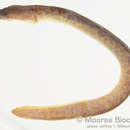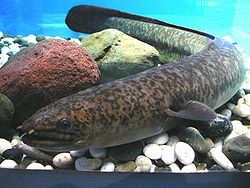pms
nòm ant ël fil


Anguilla marmorata, known by many common names including the marbled eel, giant mottled eel and long finned eel, is one of about 19 species in its genus, the only genus in the small freshwater eel family Anguillidae. Of the angillid eels, the marbled eel has the widest distribution, found in several discrete but intermixing populations throughout the tropics and subtropics across the southwestern and central Pacific ocean, in the northwestern Pacific as far north as Japan, and in the southeastern Indian ocean to southern Africa (Wanatabe et al. 2008, 2009; Gagnaire et al. 2011).It has been recorded in small numbers from the Galapagos (McCosker et al. 2003) though whether this is the edge of their natural range or an introduction is unclear (Vishwanath and Mailautoka 2012).
Marbled eels, like other anguillid eels, have a complex life history, spending most of their life in the “yellow eel growth phase,” during which they inhabit the bottoms of fresh and brackish continental waters.This can last 2-3 years in warmer regions and up to 20 years in colder northern areas.The eels then migrate long distances as “silver eels” to spawning regions in open ocean gullies located at depths of 150-300 meters (500-1540 feet).The spawning areas for the different marbled eel populations are not well identified, although those in the northern pacific are known to share spawning areas in the Mariana trench with the Japanese eel Anguilla marmorata (Tsukamoto 2011). The planktonic larvae hatch at sea and develop into glass eel larvae to return to continental waters.There they metamorphose into the pigmented elver stage whereupon they begin to feed and travel in schools to freshwater inland rivers, lakes, streams and estuaries where they complete their development.In areas of large shallow coastal seas, they may stay as elvers without migrating upstream to fresh waters (Vishwanath and Mailautoka 2012).
Distinguished by their mottled brown, green and yellow coloration, adults reach up to 2 meters (6.6 feet) in length; one of the largest angillids.They are usually encased in slime making them very slippery.Nocturnal carnivores, the adult eels eat a diverse diet rich in fish, amphibians and invertebrates such as crab and shrimp (Froese and Pauly 2006).Like other anguillid eels, the marbled eel is a sought-after commercial food fish, eaten at many of its developmental stages, and its fishery may well expand as other species of angillids decline (especially A. anguilla and A. japonica).Currently it is listed by the IUCN as of least concern at it is common throughout its wide range, however its potential vulnerability to decline due to fisheries pressure and habitat loss is recognized as an important parameter to monitor (Vishwanath and Mailautoka 2012).
Die Madagaskar-bontpaling (Anguilla marmorata) is 'n varswatervis wat in riviere van Madagaskar en aanliggende eilande voorkom. Dit kom ook voor in riviere aan die ooskus van Afrika vanaf die Zambezirivier tot by die Oos-Kaap. Die paling is egter meer volop suid van die Limpoporivier. In Engels staan die vis bekend as die Giant mottled eel.
Die vis is dofgeel met donkerbruin of swart vlekke op en word tot 1.85 m lank. Die Suid-Afrikaanse hengelrekord is 16.36 kg.
Die paling verkies diep rotspoele om in te woon en is snags aktief. Die spesie eet graag krappe, paddas en ander vis.
Die Madagaskar-bontpaling (Anguilla marmorata) is 'n varswatervis wat in riviere van Madagaskar en aanliggende eilande voorkom. Dit kom ook voor in riviere aan die ooskus van Afrika vanaf die Zambezirivier tot by die Oos-Kaap. Die paling is egter meer volop suid van die Limpoporivier. In Engels staan die vis bekend as die Giant mottled eel.
L'anguila tacada gegant (Anguilla marmorata) és una espècie de peix pertanyent a la família dels anguíl·lids.[4]
Les seues zones de fresa es troben a l'est de Madagascar, el sud de les illes Filipines, l'est d'Indonèsia i Papua Nova Guinea.[10][11][12]
Menja durant la nit crancs, granotes i peixos.[13][14]
És un peix d'aigua dolça, salabrosa i marina; demersal; catàdrom i de clima tropical (24°N-33°S) que viu entre 1-400 m de fondària.[5][15][16]
Es troba des de l'Àfrica Oriental (incloent-hi el riu Zambezi) fins a la Polinèsia Francesa i el sud del Japó.[5][17][18][19][20][21][22][23][24][25][26][27][28][29][30][31][32][33][34][35][36][37][38][39][40][41][42][43][44][45][46][47][48][49][50][51][52][53][54][55][56]
Pot assolir els 40 anys d'edat.[57]
És inofensiu per als humans.[5]
L'anguila tacada gegant (Anguilla marmorata) és una espècie de peix pertanyent a la família dels anguíl·lids.
Chit-phiⁿ bûn kóng--ê sī chi̍t chióng hî. Koan-î chi̍t khoán lâng, chhiáⁿ khoàⁿ Lô͘-môa_(lâng).
Lô͘-môa (ha̍k-miâ: Anguilla marmorata) sī chi̍t-chióng môa-ba̍k môa-kho ê hî-á.
Na duna (Anguilla marmorata), kilai talega me mapolo ogo, e species ni draki anguillid ogo e kunei ena Indo-Pasifika kei tikiva waidranu dauveibuli.
Na duna e carnivorous, ia tawamosimosi, ena dua na kana isausauvaki raraba, kanataki ura, kerebi, lila ika, ka boto. Sa e bogi, ka dau bulabula tu ena bogi.
The giant mottled eel (Anguilla marmorata), also known as the marbled eel, is a species of tropical anguillid eel that is found in the Indo-Pacific and adjacent freshwater habitats.[2]
Similar to other anguillids, the giant mottled eel is cylindrical with small, well-developed pectoral fins and a protruding lower jaw.[3] The eel has thick, fleshy lips.[3] The eel has dorsal and anal fins that are continuous around the tail, with the origin of the dorsal-fin between the pectoral fins and anus.[3] It has small, oval-shaped scales that are embedded in the skin.[3]
Unlike some other anguillid species, this species has a mottled color.[2][3] The adult eels are yellow with a greenish-brown to black marbling on their back and a white belly.[2][3] The young elvers have less visible marbling and are grayish to yellow.[2][3] The dorsal fin of the marbled eel is closer to the gill opening than to the anus, more anterior than other species of Anguilla.[3] Like all anguillid eels, it does not have pelvic fins.[4] The head is rounded and the snout is depressed.[4] Its teeth are small and in bands.[4] It has a total of 100 to 110 vertebrae.[2]
It can grow up to 2 meters (6.6 ft) for females and 1.5 meters (4.9 ft) for males and can weigh up to 20.5 kilograms (45 lb),[2] making it the largest species of anguillid eels. The marbled eel can live up to about 40 years.[3]
This anguillid species can be found from East Africa to French Polynesia and as far north as southern Japan.[2][3][5] In Africa, it may be found within Mozambique and the lower Zambezi River.[2] The giant mottled eel has the widest distribution of all the Anguilla eels.[3][6] It is usually found in tropical climates between 24°N to 33°S.[2] It has also been found in other more distant regions such as the Galapagos possibly due to abnormal larval transport associated with El Niño-Southern Oscillation events.[7] It is not on the IUCN Red List of Threatened Species, but in Taiwan, it is endangered.[3][8]
In 2002, a single eel was captured from a pond close to Kaupo, Maui, Hawaii, though it is not indigenous to the area.[3]
The adults of this species are demersal, living on the bottom of fresh to brackish waters, in rivers, lakes, and tributaries.[2] This species and all anguillid eels are catadromous, migrating sometimes long distances out into the open ocean to spawning over deep water.[2] A spawning area of this species is known to be west of the Mariana Islands in an area of the North Equatorial Current in the western North Pacific, but other spawning areas are thought to exist in the western South Pacific and Indian Ocean.[9]
Marbled eels spend their adult lives in freshwater or estuarine habitats, and migrate to the ocean to reproduce.[3] When the eggs hatch, the leptocephali drift in ocean currents for months until they reach estuaries as glass eels where they migrate upstream into freshwater as elvers.[3] Then, after about 8 to 20 years in brackish or freshwater, the yellow eels grow up into silver eels (mature eels), and they return to the ocean for reproduction.[3]
The marbled eel is carnivorous, but harmless, with a wide-ranging diet, eating shrimp, crabs, bony fish, and frogs.[10] It is nocturnal, so it is active at night.[10]
Like other anguillid eels, this species is used as a source of food in some regions.[3] Some restaurants buy live eels.[3] In 1992, for example, a typical 12 kilogram (26.5 lb) marbled eel retailed for one thousand US dollars in China.[3][11]

An eel habitat, Cheonjiyeon Waterfalls' pond, is a natural monument in South Korea.[12]
Large individuals of this species are also highly regarded and are not harmed by native people in some island groups of the western Pacific.
The giant mottled eel (Anguilla marmorata), also known as the marbled eel, is a species of tropical anguillid eel that is found in the Indo-Pacific and adjacent freshwater habitats.
Anguilla marmorata Anguilla generoko animalia da. Arrainen barruko Actinopterygii klasean sailkatzen da, Anguillidae familian.
Espezie hau Agulhasko itsaslasterran aurki daiteke.
Anguilla marmorata Anguilla generoko animalia da. Arrainen barruko Actinopterygii klasean sailkatzen da, Anguillidae familian.
Anguilla marmorata
La grande anguille marbrée (Anguilla marmorata) est une espèce d'anguille tropicale de la zone Indo-Pacifique. Sa longueur peut atteindre 2 m.
Anguilla marmorata is een straalvinnige vissensoort uit de familie van echte palingen (Anguillidae).[1] De wetenschappelijke naam van de soort is voor het eerst geldig gepubliceerd in 1824 door Jean René Constant Quoy en Paul Gaimard.[2] De soort werd ontdekt bij het eiland Waigeo (Vaigiou in het Frans) op de expeditie van de Franse korvetten l'Uranie en la Physicienne van 1817-1820.
De soort komt voor in de Stille en Indische Oceaan van Mozambique tot Frans Polynesië en het zuiden van Japan. Ze wordt commercieel gevist en gekweekt.[1]
Bronnen, noten en/of referenties
Cá chình hoa (danh pháp hai phần: Anguilla marmorata) là một loài thuộc Bộ Cá chình (Angulliformes).
Các chình hoa có thân hình dài rắn, thiếu vây bụng, đôi khi cả vây ngực. Vây lưng và hậu môn dài, phía sau thường gắn với vây đuôi, không có gai cứng. Bong bóng thông với ruột.
Trên thế giới, cá chình giống Anguilla có khoảng 20 loài, phân bố khá rộng, trừ Nam, Bắc cực ra, các châu lục khác đều có. Khu vực Trung Tây Thái Bình Dương có 11 loài thuộc giống Anguilla.
Ở Việt Nam, theo các tài liệu nghiên cứu trước đây, cá chình giống Anguilla có 5 loài là: Cá chình Phi: A. nebulosa McClelland, 1844; cá chình nhật: A. japonica Temminck and Schlegel, 1846; cá chình hoa: A. marmorata Quoy and Gaimard, 1824; Cá chình Xêlêbet: A. celebensis Kaup, 1856; và cá chình Ấn Độ: A. bicorlo picifica Schmidt, 1928 [Nguyễn Hữu Phụng 2001].
Theo các nghiên cứu mới nhất ở Việt Nam cá chình giống Anguilla chỉ có 3 loài là cá chình hoa A. marmorata Quoy and Gaimard, 1824; cá chình mun: A. bicorlo bicorlo McClelland, 1844 và cá chình nhọn: A. malgumora Kaup, 1856 [Hoàng Đức Đạt, Nguyễn Xuân Đồng, Nguyễn Xuân Thư, 2006].
Các loài cá chình giống Anguilla có chu kỳ sống rất đặc biệt: sinh trưởng trong nước ngọt đến tuổi thành thục, trưởng thành sinh dục, di cư ra biển để sinh sản. Trong quá trình di cư, tuyến sinh dục phát triển, chín muồi và sinh sản ở vùng biển sâu. Trứng thụ tinh, phôi phát triển nở thành ấu trùng dạng là liễu, sống phù du trong nước biển, theo các dòng hải lưu trôi dạt vào bờ, biến thành có chình dạng ống trong suốt, vào cửa sông-hạ lưu biến thành cá chình con. Cá chình con theo dòng nước ngọt di cư lên thượng nguồn các sông, suối, các hồ chứa nước ngọt để sinh sống cho đến lúc trưởng thành.
Các loài cá chình giống Anguilla chỉ sinh sản một lần trong đời sống. Sau khi sinh sản, cá chình bố mẹ chết.
Cá chình hoa (danh pháp hai phần: Anguilla marmorata) là một loài thuộc Bộ Cá chình (Angulliformes).
鱸鰻(學名:Anguilla marmorata),俗名花鰻、烏耳鰻,為輻鰭魚綱鰻鱺目鰻鱺亞目鰻鱺科的其中一種。
分布於印度太平洋區,包括東非、馬達加斯加、中華人民共和國、法屬波里尼西亞、菲律賓、日本南部、台灣、印尼、澳洲北部、索羅門群島、帛琉、密克羅尼西亞等河川溪流皆有其蹤跡。
體延長呈圓柱形,但肛門後的尾部則稍側扁。鱗片細小,體灰黑或黃褐但具有斑紋,腹部為銀白色;背鰭和臀鰭都是低平而一直延伸到尾部,和尾鰭連結成一體而不易區分彼此。體長可達160公分。
棲息在砂泥底部的肉食性魚類,鱸鰻的成長過程和日本鰻鱺相似,其幼魚在河川中成長,成魚在春末夏初降海產卵,孵化後的仔魚經柳葉形期的變化成透明的鰻線,需耗時五個月,才再回到河裡生存。白天全身隱藏在泥地中,只有露出一個頭部呼吸,到了夜晚即游出覓食,以其它魚類、蝦、蟹為食。
在台灣曾列為保育類魚類,當時市場上的鱸鰻多屬進口。2009年在專家學者研商後,認為資源恢復,且非臺灣的特有種,因而將鱸鰻從保育類物種中移除。目前臺灣已能人工養殖。常佐以中藥材燉煮食用。 中国国家重点保护动物二级。

オオウナギ (大鰻、英: Giant mottled eel、学名: Anguilla marmorata)は、ウナギ目ウナギ科に属する魚である。和名のとおりにウナギよりも大型である。ウナギの大型個体を「大鰻(おおうなぎ)」と呼ぶこともあるが、オオウナギとウナギとは同属別種である。オオウナギはウナギよりも熱帯性が強い。地方ではカニクイなど様々な呼称で呼ばれている。
オオウナギは最大で全長2m・体重20kgに達する。背中側は黄褐色の地に黒褐色のまだら模様があり、腹側は黄白色をしている。オオウナギの若い個体はウナギと同様細長い体型をしているが、大型個体は胴回りが丸太のように太くなることから、ウナギとは別種であることがわかる。若い個体は、体表にまだら模様がある点でウナギと区別できる。ただし、個体によっては模様が薄くウナギとの区別が難しい場合もある。なお、オオウナギはタウナギとも別種(別科別属)である。タウナギには胸びれがなく、体表のまだら模様もまばらである点から、オオウナギと区別することができる。
オオウナギは、太平洋とインド洋の熱帯・亜熱帯域に広く分布し、ウナギ科全18種類のうちで最も広く分布している。日本では利根川以西・長崎県以南の暖流に面した地域に生息地が点在する。南西諸島ではオオウナギはウナギよりも多い普通種である。
オオウナギは、川の流れが緩い場所や湖、池、マングローブなどに生息している。オオウナギは日中、岩や植物の隙間に隠れて休み、夜になると泳ぎ出て獲物を探す。雨の日には、特に若い個体が水場を抜け出て他の水場へ移動することがある。
オオウナギの食性は肉食性である。主に甲殻類、小魚、カエルなどいろいろな小動物を捕食する。特にカニ類を好むといわれており、 オオウナギの地方名にはカニクイというものもある。
オオウナギは、繁殖の際に川を下り、外洋域の深海で産卵する。この点でウナギと同様である。卵から孵ったオオウナギの稚魚はレプトケファルスの形態で外洋を漂いながら成長を続け、全長5cmほどのシラスウナギとなって各地の海岸に現れ、川を遡上する。寿命は40年という記録がある。
鹿児島県南部や南西諸島、台湾などではオオウナギは食用や強壮剤にされる。ただし、ウナギより不味とされている。
ゴマウナギ(高知県)、カニクイ、カニクイウナギ、アカウナギ(九州)など
オオウナギは熱帯性の種であるため、日本の九州以北では目にする機会が少ない。1999年に公表された環境省レッドリストには記載されていないが、オオウナギの生息地は各地で天然記念物に指定されている。
これら以外にも、各県や市町村レベルでオオウナギが天然記念物に指定されている場合があるため捕獲には注意を要する。
オオウナギ (大鰻、英: Giant mottled eel、学名: Anguilla marmorata)は、ウナギ目ウナギ科に属する魚である。和名のとおりにウナギよりも大型である。ウナギの大型個体を「大鰻(おおうなぎ)」と呼ぶこともあるが、オオウナギとウナギとは同属別種である。オオウナギはウナギよりも熱帯性が強い。地方ではカニクイなど様々な呼称で呼ばれている。